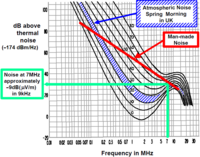
Photo from wikipedia
Improvement in the signal-to-noise ratio of Nuclear Magnetic Resonance (NMR) systems may be achieved either by increasing the signal amplitude or by decreasing the noise. The noise has multiple origins… Click to show full abstract
Improvement in the signal-to-noise ratio of Nuclear Magnetic Resonance (NMR) systems may be achieved either by increasing the signal amplitude or by decreasing the noise. The noise has multiple origins - not all of which are strictly "noise": incoherent thermal noise originating in the probe and pre-amplifiers, probe ring down or acoustic noise and coherent externally broadcast radio frequency transmissions. The last cannot always be shielded in open access experiments. In this paper, we show that pulsed, low radio-frequency data communications are a significant source of broadcast interference. We explore two signal processing methods of de-noising short T2∗ NMR experiments corrupted by these communications: Linear Predictive Coding (LPC) and the Discrete Wavelet Transform (DWT). Results are shown for numerical simulations and experiments conducted under controlled conditions with pseudo radio frequency interference. We show that both the LPC and DWT methods have merit.
Journal Title: Journal of magnetic resonance
Year Published: 2018
Link to full text (if available)
Share on Social Media: Sign Up to like & get
recommendations!